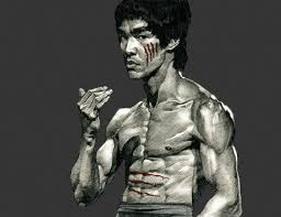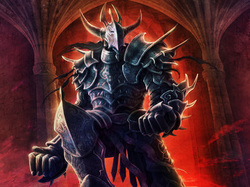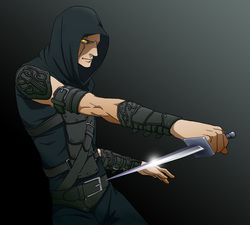 Terror in it's purest form. Gamer Forge Listener Email: Name Richard Jacobs Comment I'm interested in when this constraint from vampire lore was first integrated into Dungeons and Dragons mechanics: has it been there since the first D&D vampire? Vampires are... unable to cross running water, although they can be carried over it while resting in their coffins or aboard a ship. The garlic legends I'm passingly familiar with, mirrors, crucifixes and inability to enter uninvited also. When was the first D&D vampire unable to cross running water? Is there some sort of explanation in any game-related material apart from "that's the way it is?" This came up during a pre-made adventure. In this game a vampire was entombed in an underground complex. After failing to defeat the vampire in his own tomb (I know, my characters rocked) his next move as per the module was escape out the front. Unfortunately for the author they constructed the adventure so that we had to cross a stream before we even entered the complex. In the eyes of a 3.5 (possibly earlier?) vampire this means nigh-certain containment. My characters destroyed his coffin and steal his grave dirt (leading to abuse of the phrase "I've got a jar of dirt") and the DM had him dominate people across the stream to dig him out from above the cavern, effectively sidestepping that quirky rule. After a few months, though, I haven't been able to puzzle out why that weakness even exists. Is there any official discussion of the implications of vampire weaknesses in D&D and how to work with them? Gamer Forge Response: Because Role-Playing Game, that's why. DCR says: 1. Since always. Vampires were included in the original box set in 1974. The commonly held stories were used as part of the D&D mythos from the start. It's about commonality. The term "vampire" is so ubiquitous with our culture, the image so ingrained in the collective education of the last century, that "vampire" has a history book all it's own. If D&D were to suddenly change the definition for their game, nobody would want to play it. Part of the allure of fighting Dracula is the feeling of heroism that comes from defeating Dracula. If Dracula were to suddenly resemble Chewbacca, then the prospect of defeating him isn't cool anymore. 2. You have to quantify the challenge to put it in context with a game. Defeating or otherwise successfully navigating a vampire must be worth something, or worst case scenario, failing to defeat the challenge must be worth something as well. 3. The idea of vampires having limits isn't something invented for the game. The reason a vampire has weaknesses is so we can contain it within our own imaginations. If we envision an embodiment of pure evil and temptation and it has no weakness, it crosses the boundaries into a psychosis. It becomes something that in our own minds can't be stopped. We become terrified of our own idea. Not cool.  Forsooth! I have come in the name of Pelor to smite evil! Gamer Forge Listener Email: Name Stanley Finnley Comment In just about every edition of D&D (save for 4e), Paladins are required to be Lawful Good. If they stray from that, they are completely stripped of their powers. This means that evil deities can't grant powers to paladins or if they do, they go into a new class (e.g. Anti-Paladin). My question is: why? Why was it designed that paladins have to have such a strict alignment? It seems to me that it unnecessarily pigeonholes the character types and doesn't make sense in D&D world. After all, couldn't evil deities have holy warriors? I also don't understand the mechanical decision about why was it designed that an evil Paladin has to be a different class. Wouldn't this create a problem if you wanted to redeem an evil Paladin into a good one? This never really made sense to me until 4e where they just dropped the Lawful Good restriction entirely and let you have a Paladin of Vecna (or have that Paladin of Vecna become a redeemed Paladin of Pelor without having to switch classes). Gamer Forge Response: Another Paladin question!?!?!?! Are you guys trying to stump us with this subject, or is it legit confusing? DCR mercifully says: 1. The alignment isn't strict. The tenants of the deity are. "Lawful" can (and does) indicate adherence to a code. "Good" indicates that the code is good in nature. This also should not have a bearing on the personality of the Paladin in question. Put the two together, and you shouldn't get "lawful stick-up-the-butt". 2. The Paladin becomes an "Anti-Paladin" or "Blackguard" prestige class if and when they deviate from the deity's tenants or in some way lose favor with their deity. Remember, a "paladin" is an exemplar of the deity's aspects or "domains". Part of the code of conduct should include advancement and perfection of those aspects. Similar to the aspects of a "monk". 3. But in 4th edition D&D, the "Blackguard" becomes a character class from 1st level. The "good" thing isn't really a factor. You can find it in Heroes of Shadow supplement book. In all honesty, it's not very good. Seriously, it's soooo not worth it. Gamer Forge listener Email:
Name Mystery Man Comment Can a sleeping character hide at all? If they do so, do they roll Hide when they go to sleep (for hiding their sleeping spot, etc.), or do they make an opposed roll every time someone attempts to spot them? Gamer Forge Response: When trying to grab a few extra winks, DCR says: 1. Finally, an easy one. You can attempt to hide yourself before you go to sleep. That's called camouflage. But you can't do it while you're sleeping, as it is something that you must concentrate on. Bonus XP: The Paladin and Monk have a good deal in common. Indeed, the two could learn more than one thing from each other. The Monk follows an ideal along the lines of "pursue to perfection", hence the physical training regimen. Also, think of concepts like "mind over matter" and apply them to the Paladin. While you're at it, why not create your next character as a Monk, but call yourself a Paladin. Now you can see the similarities, we hope. Also, take a trip back in time by watching Enter the Dragon with Bruce Lee. A good guy following a code of honor while fulfilling the tenants of his order and questing? Yep. That's a paladin, all right!
0 Comments
 Gamer Forge Listener Email: Name Calvin MacDonald Comment Gentlemen and the lovely Firebird. I first want to say thank you for putting on such a great show. I've been listening t for the last year and I have to say you have had an amazing line up of guests! I'll be honest I don't get to see to many of the guest you've have on the show over here in Perth, Scotland. So with that said greetings from across the pond! And I'd like to know where Lord Flagoon has a plot oh land and when he plans to come across the pond and have a pint with us! And now for my gaming question. One of my players wants to play an unarmed fighter. What I need to know is; do spiked gauntlets count as weapons or as armor for the purposes of enchanting? I hope you can help me out and Lord Flagoon we'll always have a pint wait'n for yah! Gamer Forger Response: This one was easy. When you gotta have spikes on them fisteses, DCR says: Spiked gauntlets make you armed even when you aren't holding a weapon. When enchanting spiked gauntlets, they count as weapons, not armor. Enchant accordingly. Gamer Forge Listener Email: Name Jack Reynolds Comment My question is quick and simple. Could an undead in 3.5e D&D such as a skeleton benefit from wearing magic items like rings of protection? Gamer Forge Response: We don't always give our skeletons magic items, but when we do: Sure. Rings of Protection count as a deflection bonus, thus can stack with different bonuses that a skeleton or other undead may have. The only similar bonuses that stack are "dodge" bonuses. So a deflection bonus stacks with a natural armor bonus, which stacks with a luck bonus, etc., to calculate an Armor Class. Stay armored, my friends.  Gamer Forge Listener Email: Name Steven Rostenberg Comment Can a Rogue (D&D 3.5) use sneak attack on both the first and second attack? I know this seems like a question you can simply Google but the answers vary and my clan is under the impression that I can only use it on my first attack (once per round) and not on my second attack. From Googling, I've understood that as long as the monster / enemy is flat-footed, flanked or caught off-guard, I can apply sneak attack on both my first and second attack in a round. Is this correct? Is it normal if the clan simply decides that that gives me an unfair advantage in combat and gives me only one sneak attack per round? Gamer Forger Response: Sneaky, sneaky! When getting your sneak on, DCR says: 1. If for some reason you get multiple attacks, you get to apply the sneak attack bonus damage to each successful hit. Here's the justification: sneaky types (typically) aren't gonna be wielding the large weapons and (usually) don't have access to powers and special abilities that enhance their normal damage output. They're just not built that way. But they have to get an edge somehow. With that being said... 2. Full-round actions. Multiple attacks can only be taken as part of a full-round action, meaning if you move or do anything else during your turn, then you only get the one attack. A lot of what a sneaky type does, is move and juke and jive around the battlefield, so getting multiple attacks in a round is usually out of the question. If for some reason, your sneaky type manages to stay still and have an enemy back up into him/her, well, then that means you don't have to move, and can take multiple attacks, dealing full sneak attack damage on each successful hit. It sounds like a lot of work, but that's part of getting the most out of your sneaky type. 3. Know your role. "Rogues" aren't really known for carrying the giant swords and battle axes. It's just not their bag, baby. Besides, "rogues" should be focusing their efforts into filling in the gaps that might be missing within the party. Every adventuring group needs a resident pimp. Just saying. Gamer Forge Listener Email: Name Raz Dragon Comment Okay so I really need you help because my last game session didn't end up so well and I am just not sure what to do here? Let me explain what happened. My player which I will call Steven rolls to attack during a big encounter that progresses the story and he, rolls a 1. Next round, rolls a 1. Round after that, rolls a 1. Fourth round, rolls a 2. I'm serious this really happened all night his rolls were never higher than a 6 or 5 and he was going back and forth between two different dice too. It just so happened that this whole encounter had outrageously unlikely rolls and all the players seeing more low single digits than they had any right to, while I ended up rolling four d20s all at once for an area attack and getting four 20s. At some point or another, all the role-playing in the world doesn't save you when the dice are just not in your favour. What is a DM to do in such situations where players are getting frustrated at the dice and, as a result, are getting upset with the game? Gamer Forge Response: Lastly, when things are looking grim for the group, DCR says: 1. It's just a game, and a game can be put on pause. It's cool to take a break, get a breather, grab a drink, make a corner-store run, something. Everybody, and I do mean everybody, has a bad night of dice rolling. That's what happens when you play with probability. Law of Averages says you will encounter times like this. Oh, well. No matter how awesome you have yourself set up to be, you will fail every once in a while. The only piece of advice regarding this would be : "cope with it". You will not be awesome 100% of the time. 2. Beware of escalation. It may be tempting to offset a bad night of rolling by permanently enhancing the characters with magic or other means. Don't do it! There is no substitute for probability. Part of playing the game is rolling the die and risking not winning that night. To cheat probability like that is to miss the point of playing a game, period. 3. So everyone ended up dying? Is that really the end of the world? DM's take a lot of time to come up with cool stuff to happen each week, and it stinks when it gets shelved due to a TPK (total party kill). There's no reason bits of what you had planned can't just be transplanted into a new story. Don't let a bad night of rolling wreck your whole experience of Dungeon Mastering, or playing an RPG in general. *Bonus XP: To get a good grasp of what it means to be part of a team, try watching episodes of Leverage. Each member of the team has a distinct, specialized role and each one of them is specialized to the point that they are the only ones who can do it. Sure, what they do is usually illegal. Okay, almost all the time it's illegal. Point being, a "rogue" should be able to fill roles within a group that aren't being covered, and do it well enough that they won't be replaced anytime soon. That's one of many things that make a good team. Each member contributes in a unique way, and goals are achieved due in no small part to that unique help.  Gamer Forge Listener Email: Name: Kraven Comments: I am having trouble coming up with a game session that involves the undead. I have been watching movies like Resident Evil, Shaun of the Dead, Zompieland, and a few others to get some ideas. But every time I write it seems to fall flat. Can you guys help me out here? Setup: Group has been commissioned by local church leaders to eradicate the infestation of undead that have suddenly appeared in a cathedral that is located in a small vale up in the mountains and most of the inhabitance there have been wiped out. How do I Make this game fun without constantly throwing zombies and skeletons at them?? Gamer Forge & Terron James Response: A good thing to remember when writing an undead campaign is how you want to pace it. Do you want a survival to the last running at top speed to get to safety game, an atmospheric scary crawl where the characters are wondering what’s behind every corner, or do you want one where they can feel true power plowing through wave after wave of thoughtless beasties. Here’s some thing’s that came to mind during my mindless rants on the show: 1. Make the story unique and avoid cliché’s. We’ve all played /seen the, “Necromancer spell gone wrong” campaign to death; as well as “opened a gate way to (blank).” Make it fun like that commercial about weeklong blackout causing some milk to go bad and the guy drank it anyway causing him to become “patient zero” and starting the zombie outbreak. Or better yet don’t have a fully fleshed out reason why the dead are raising sometimes these things happen without reason. Leave subtle bread crumbs hinting as to what could have caused it. 2. Pacing will be the key to making this campaign work. You want to set an atmosphere where the players are going to scare themselves. Take your time don’t just drop them in a town with a horde of undead in the middle of town square. Start off with the town being empty make them thing that it is abandoned get them sucked into exploring all the houses trying to figure out where everyone is then when they least expect it BAM! Hit them with a crawling, legless zombie or ghoul catching their healer by surprise. 3. The unknown is your friend. The less you give your players the more intrigued they will become. The element that is going to scare your players more is their own imagination’s filling in the blanks. 4. Show the danger’s in dealing with the undead. Have a NPC come along with them who will die soon into the story and have s/he turn right in front of their eyes. Show them that if you go down or die here you’re going to become one of them. Other sources to get more ideas: The “Paranormal Activity” movies are a great example in pacing. (PA2 and 3 don’t watch 1 that one sucked.) Play Silent Hill 2, Amnesia: The Dark Prophecy, Half-life 2 “We don’t go to Ravenholm” chapter, the “Evil Dead” movies are a good way to do a poltergeist, and a good on line vid that talks about horror in video games but is still relevant is Extra Credits “Where did horror go” (http://penny-arcade.com/patv/episode/where-did-horror-go) |
The GamerForge is DungeonCrawlersRadio’s most favoritist segment of the entire show. Have you ever had a boggling rules question that no one in the group can figure out? Write in to us and we’ll help try to solve it! Are you a Game/Dungeon Master who needs help squashing animosity at the table or dissension in the ranks? Perhaps we can help!
If you are in need of help, encouragement, or an uber devious way to get a TPK, we are here to help. No matter your needs, we’ll help you get more from your gaming! The Gamer ForgeWhere Players & Game Masters can come for valuable information to level up your game! Archives
August 2013
Categories
All
|
 RSS Feed
RSS Feed








